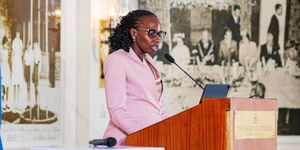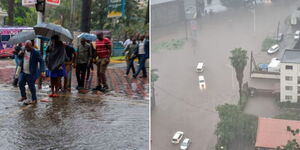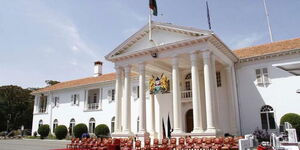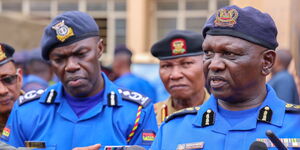Engineer Michael Kamau is a career public officer who joined the civil service from the entry-level civil servant and rose to CS in the same ministry.
Born in 1958 in Nyeri, Kamau attended Hill Farm Primary School before joining St Mary’s Boys Secondary School. He proceeded to Nyeri High School for his O’ and A’ levels and later to the University of Nairobi to pursue civil engineering.
He also attended the University of Newcastle Upon Tyne, UK, for a master's degree in Engineering and undertook professional engineering courses at the South Korea Institute of Construction Technology and the Belgian Road Research Centre.
A technocrat with a track record spread all over the country in the form of national policies, roads, office blocks and mega infrastructure projects, Kamau had the engineer’s flair not just for building things but for fixing broken stuff as well.
He served as Permanent Secretary under both the late powerful Ministers Simeon Nyachae and John Michuki, and it was not until 1998 when he tried to resign from government to join the private sector only for him to be recalled by then president Daniel Moi.
He considered retiring towards the end of late president Mwai Kibaki's tenure to run for governor in his home county of Nyeri but deputy prime minister and presidential candidate at the time Uhuru Kenyatta prevailed on him to stay put and wait to be in his administration if he won.
Kamau joined the public service as an assistant engineer in 1981 and rose through the ranks to Permanent Secretary, before being appointed a Cabinet Secretary (CS) Transport and Infrastructure by President Uhuru Kenyatta in 2013.
It's in under Kibaki's tenure in 2007 that he rose from assistant engineer to engineer, then superintendent engineer, senior superintending engineer, chief superintending engineer, principal superintending engineer, chief engineer, Roads Secretary and, finally, Permanent Secretary.
Kamau was part of a core team that supervised the completion of stalled projects such as Nyayo Wards, several district headquarters, the Nyanza Provincial Headquarters, and police housing across the country.
Enactment of the Engineers Act gave the engineering board wide ranging powers as opposed to the repealed Engineers Registration Board Act which had very limited provisions.
This new Act empowered the engineering fraternity through its Board to participate in the training of engineers, setting of professional fees and enforcing the engineers’ code of conduct.
Further, he spearheaded the enactment of the Roads Act followed by establishment of the Kenya National Highways Authority (KeNHA), Kenya Urban Roads Authority (KURA) and Kenya Rural Roads Authority (KERRA).
This was aimed at bringing in public participation in road development and maintenance as well as increase the capacity of government to handle roadworks.
Kamau pushed for the formation of an organization by the road contractors. This culminated in the formation of the Road and Civil Engineering Contractors Association (RACECA).
The government was now able to have structured dialogue with the contractors. RACECA was also made one of the nominating bodies for appointment to the board of NCA.
He championed the construction of the Kenya Civil Aviation Authority (KCAA) headquarters and even laid the the foundation of the new building.
This was intended to give KCAA autonomy taking cognizance of the fact that KAA was the landlord of KCAA who were their regulators thus creating fertile grounds for conflict of interest.
At Mombasa Port, he restructured port operations by making the managing director Kenya Maritime Authority (KMA) chairperson of port stakeholder’s forum as opposed to the MD Kenya Ports Authority KPA who was conflicted as chair of the forum.
He also streamlined the weighbridge operations through KeNHA and the police.
The results of this reorganization were immediate. For starters, the travel time for cargo containers from Mombasa to Kampala dropped from two weeks to 4 days.
The port for the very first time handled more than one million containers in the year 2014 thus placing it in the league of the big ports globally.
Further, the Engineer also laid the groundwork for the Dongo Kundu by-pass Project, a crucial transport corridor to reduce traffic on the Makupa course way and the Likoni Ferry and decongest Mombasa Island.
As CS Roads and Infrastructure, he was instrumental on the rollout of the Standard Gauge Railway (SGR) project.
This also involved the major expansion of the inland container depot (ICD) in Nairobi and the necessary roadworks to facilitate easy evacuation of cargo from the ICD.
It's during his reign as CS that breathalyser tests to curb drunk driving was introduced,and penalising of matatu saccos whose errant operators caused fatal accidents due to negligence and disregard of the law.
His progressive stunt was halted on 28th March 2015, barely two years after assuming office as CS, he stepped aside from office together with Felix Koskei (Agriculture), Davis Chirchir (Energy), Charity Ngilu and Kazungu Kambi (Labour) over an Ethics and Anti- Corruption Commission (EACC) report linking him to graft.
After taking over from Uhuru, President William Ruto appointed Kipchumba Murkomen to head the transport docket - a crucial ministry that could break or make his legacy.












